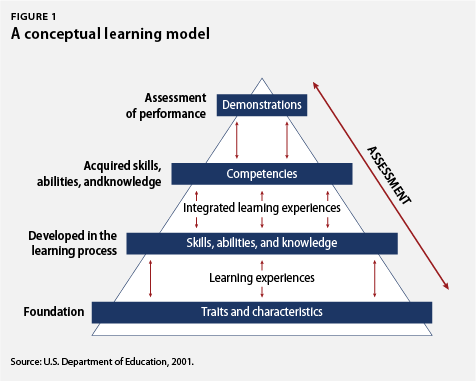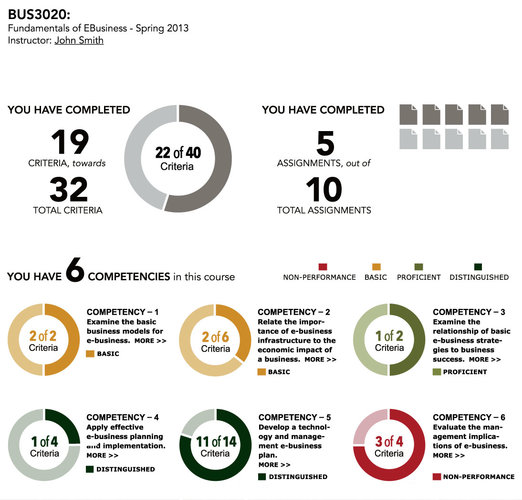The essential difference between competency-based education (CBE) and traditional programs is that CBE measures learning without regard to time. They utilize direct measures of assessment to determine understanding of content, as opposed to requiring a certain number of credits or contact hours of class time in order to earn a letter grade. Students instead demonstrate what they know when they know it well enough to be deemed competent. In essence, it is much like an AP exam, only on a far larger scale: AP students must pass a test with a certain level of competency in order to earn credit for the course. Students in a competency-based program must do the same for each course they undertake.
The first program completely based on competencies rather than credits was green-lighted by the Department of Education in August of 2013 at College of America, a community college associated with Southern New Hampshire University. Since then, there has been a push for this type of system to be implemented at community colleges across the country. This movement is the result of several shifts in the landscape of higher education in recent years. As the cost of a college education continues to rise, community colleges, universities, federal agencies, and private entities have been exploring a less expensive way for students to obtain a degree or certification. The individualized pacing of CBE is seen by many as a solution to this problem, as it is a system of learning completely free of time-based instruction.
Secondly, with increasing numbers of non-traditional adult students returning to community colleges to finish their education, many educational experts believe that these students should be able to apply their wealth of life and career experience to obtain college credit. Under a CBE framework, these students would be able to test out of competencies they’ve already mastered. Again, the idea is that by empowering students to utilize what they already know to fulfill course requirements, the amount of time they require to finish their degree is greatly diminished.
Lastly, as the economy continues to recover from the Great Recession, the need for highly-skilled workers has risen dramatically. In particular, the medical, technological, and oil and gas industries have thousands of job openings for workers who typically only need an associate’s degree or certificate in order to acquire a well-paying job. CBE may be the answer for helping students acquire these skills quickly and fill vacancies in the workforce.
Defining “Competency”
The general consensus is that competency is equivalent to a level of 86% proficiency. While this figure will likely fluctuate from college to college, it is certain that it will be a level of achievement comparable to an above-average grade in a traditional class. Beyond competency is the concept of mastery, which holds students to a far higher standard. Students can demonstrate mastery by undertaking a more robust application of what they’ve learned, such as writing a paper, developing a case study, or taking additional tests. Concepts on which a student obtained partial or full mastery would be designated as such on their transcripts.

Most current competency-based programs allow students to work independently and submit their work to professors for review. These professors then provide feedback and direct students towards improved competency if needed. Although the day-to-day interaction between professor and student is largely absent from CBE, student work will still be the subject of review by a qualified educator who has the final say in determining a student’s level of understanding.
Benefits of Competency-Based Education
Proponents of competency-based learning are quick to point out that the flexibility of such a system allows students to spend less time demonstrating what they already know in favor of devoting their energies to areas in which they are not as competent. For example, a community college student who has an excellent grasp of English composition may be able to complete his or her first year of college English in a matter of weeks or months by proving their competency in that particular field of study. That proof, unlike in a traditional system, may come from earlier learning, on-the-job experience, or general life experience. Doing so allows that student to dedicate more time to a subject area in which they aren’t particularly strong. It is this personalized learning experience, in which an individual student’s needs drive the content of their study, which gives this system such great flexibility.
Furthermore, this flexibility means that students can fast-track their way to their degree or credentials because they don’t have to spend a semester in classes in which they can demonstrate competency on day one. This means that students can complete their community college studies in less time, freeing them up to pursue further educational opportunities or employment more quickly. Additionally, because students are able to demonstrate their competencies by testing out of specific courses, they can significantly reduce the cost of their education, and in turn, reduce the amount of student loans many people require to complete their education. The savings of time and money can prove to be a significant boon to students, especially those who are poor, have families, full-time jobs or other considerations for their time and money.
Advocates of competency-based programs purport that direct assessments that are so popular in these systems force colleges to measure with far more specificity the academic knowledge they are providing to their students. Rather than a stand-alone letter grade on a transcript, colleges would instead provide detailed information regarding standards, benchmarks, and the specific competencies a student successfully demonstrated during their studies. In light of declining academic standards and increasingly common reports of grade inflation in higher education, supporters of CBE argue that such detail is needed.
A final benefit of CBE systems is that they would be relatively easy to implement at community colleges, because competencies already form the basis of many of their degree programs. Most community colleges already offer industry-specific credentialing programs, so expanding that model to include pathways for completing purely academic studies seems well within the realm of possibility.
Critiques of Competency-Based Education
Likely the greatest criticism of CBE is that it is nothing more than a cheap version of a real education. A student who guides him or herself through independent study is not on par with a student who attends class and whose thinking is challenged by a subject-matter expert. There is no equal value there. A budget education, they say, is the same as having a fast-food dinner: it’s cheap, quick and easy, but in the end, doesn’t provide you with many long-term benefits.
A second concern is that competency-based education is too flexible in terms of the kinds of learning that are accepted toward one’s degree or certification. Some programs give the same amount of credit to a student who has demonstrated their learning through playing video games as they do to a student who has attended a semester-length class. Such programs are far less concerned with howa student acquires their knowledge, so long as they are able to showwhat they have learned.
Additionally, experts argue that while CBE purports to save students a lot of money while getting them credentials in a much shorter time frame, these programs will only serve to exacerbate class and race-based inequalities in higher education. Poor students, whose pocketbooks often dictate where they attend school and for how long, would naturally be drawn to a program that can be completed faster. Meanwhile, wealthy students, or those who have performance or need-based financial aid, could continue to attend traditional schools and receive open-ended instruction that fosters the development of higher ordered thinking skills. This, in turn, serves to establish a separate-but-equal landscape in higher education, with poor students relegated to CBE programs that offer them few intellectual challenges and more affluent students able to take their pick of traditional programs that facilitate far more academic growth.
Another grey area is how a student in a competency-based program would fare if they transferred to another community college or to a university. Since competency-based programs do not operate on a per-credit basis, ensuring that the work students have completed will translate into credits at their new college could cause headaches for college admissions officers and registrars, at least in the interim. A potential solution to this problem would be for students to be granted credit equivalencies for their work in a competency-based course. For example, once a student completed all the necessary competencies for Business Math 101, they would earn equivalent credit for the conventional Business Math 101 course. This traditional credit would be noted on the student’s transcript, thus making it more likely another institution will accept their work.
Federal Support of CBE
The Obama Administration has been supportive of exploring alternative methods of measuring student success in an effort to reduce college costs and prepare a skilled workforce more quickly. Among the numerous suggested innovations it would consider, the Department of Education has honed in on CBE and has strongly urged input on how CBE systems can be implemented. In response, a group of 17 community colleges and universities, including Broward Community College and the Kentucky Community and Technical College System, submitted recommendations that include a revised definition of “attendance” and “satisfactory academic progress,” as well as a separation of financial aid from traditional time-based requirements such as the semester, quarter or credit hour.
It is the third recommendation that has received the most attention from the federal government. In 2013, Education Secretary Arne Duncan released a statement that provided community colleges and universities guidance with regard to administering financial aid to students in competency-based programs. In it, Secretary Duncan reminds institutions that students may be eligible for Title IV funds, which are governed in part by the direct assessment clause of the Higher Education Act of 1965 and the Higher Education Reconciliation Act of 2005. It is the second piece of legislation, in particular, that allows community colleges to offer financial aid to students whose progress is determined by direct assessment rather than credit hours. So long as a student’s course of study is entirely based on competencies – hybrid programs are not included – that student can receive Title IV funds, which include federal student loans and Pell grants.
To ensure that money spent by students on competency-based programs garners an education that is equitable to traditional coursework, the Department of Education issued the following guidelines for financial aid:
- Institutions wishing to grant Title IV funding to students in competency-based programs must apply for approval from the Department of Education.
- Institutions must demonstrate how equivalencies are determined between credit hours and direct assessment methods.
- Institutions must get approval for these programs from their accrediting body.
- Financial aid may only be awarded for learning that takes place under the supervision of the current institution.
Additionally, the United States Department of Labor has provided several grants to community colleges that seek to develop competency-based programs. Private entities, such as the Bill and Melinda Gates Foundation, have also contributed millions of dollars to the effort. However, these contributions are just a drop in the bucket compared to the $1.5 billion the Department of Labor is funneling into community colleges to improve workforce development, of which competency-based programs are a part.
Toward the Future
If CBE is widely adopted at the community college level, it will be a move that will have lasting impacts on various aspects of higher education. In addition to potentially reducing costs of time and money for students, community colleges will have to adapt the way they credential a student’s learning. Specifically, CBE may usher in a skills-based method of credentialing known as a Competency Report. Northern Arizona University has pioneered the development of this kind of credential, which offers specific insight into the knowledge and skills each student obtains in their studies. This report may well serve as the basis for credentialing at community colleges in the very near future. It may also usher in the death of traditional transcripts and letter grades, which according to some experts are “useless in evaluating job candidates.” At the very least, it appears as though Competency Reports could serve as a supplement to traditional transcripts and provide potential employers with another window into the knowledge and skills a candidate has acquired over the course of their education.

In order for CBE to work, implementation on community college campuses must be undertaken with purpose. Specifically, community college personnel would need to:
- Ensure that competencies and assessments are well defined to ensure students are mastering the material adequately.
- Completely reconstruct the role of professors and their relationship with students. Rather than lecturing and disseminating knowledge tostudents, professors would instead act as a guide, allowing students to discover learning on their own, while being available to provide extra guidance if necessary.
- Utilize the burgeoning power of technology to provide support for students as they undertake individualized instruction.
Whether one supports competency-based education or not, it appears likely that it will become a far more significant aspect of higher education in the coming years. In part a much-needed update to the antiquated higher education system that takes a one-size-fits all approach, and in part a drive-thru mentality to obtaining a degree, competency-based education is sure to change the landscape of the community college experience for decades to come.















